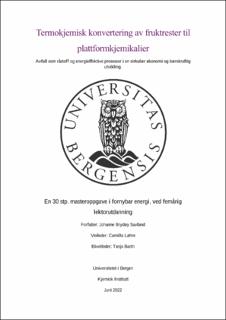| dc.contributor.author | Savland, Johanne Brydøy | |
| dc.date.accessioned | 2022-07-01T00:08:54Z | |
| dc.date.available | 2022-07-01T00:08:54Z | |
| dc.date.issued | 2022-07-01 | |
| dc.date.submitted | 2022-06-30T22:05:11Z | |
| dc.identifier.uri | https://hdl.handle.net/11250/3001952 | |
| dc.description.abstract | Furfural (FUR) og 5-hydroksymetylfurfural (HMF) kan dannes ved termokjemisk konvertering av pentose og heksose i fruktrester, samt andre biomasser. Både FUR og HMF anses som høyverdige plattformkjemikalier da de kan brukes videre til å produsere produkter og kjemikalier vi hovedsakelig får fra fossile ressurser, som for eksempel bioplast og biodrivstoff. I dette masterprosjektet har hovedfokuset vært å finne gode metoder for termokjemisk konvertering av fruktrester til HMF, med ubehandlet biomasse fra plommer som råstoff. Med bakgrunn i FNs 17 bærekraftmål (spesielt bærekraftmål 7 og 12) og hvordan den kjemiske industrien kan bidra til å nå disse, har den mer miljøvennlige katalysatoren sulfaminsyre blitt sammenlignet med den industrielt etablerte svovelsyren, med tanke på produktutbytter. Mikrobølgeassistert oppvarming (MWAH) har blitt foreslått som en mer energieffektiv konverteringsmetode og har derfor blitt sammenlignet med konvensjonell oppvarming, også med tanke på produktutbytter. Hvordan temperatur (°C), reaksjonstid (min.), type katalysator og konverteringsmetode påvirker produktutbyttene har blitt undersøkt. Identifisering og kvantifisering av biprodukter har også blitt initiert i dette masterprosjektet. Maksimalt produktutbytte av FUR på 1.3 vekt% ble nådd med sulfaminsyre som katalysator, MWAH, en temperatur på 210 °C og en reaksjonstid på 10 minutter. Maksimalt produktutbytte av HMF på 22 vekt% ble nådd med sulfaminsyre som katalysator, konvensjonell oppvarming, en temperatur på 170 °C og en reaksjonstid på 120 minutter. Generelt viste det seg at sulfaminsyre var positivt for produksjonen av HMF, mens svovelsyre var noe bedre for produksjonen av FUR. Konvensjonell oppvarming ga best utbytte av både FUR og HMF, men MWAH kutter betraktelig ned på reaksjonstider, og en temperatur på 170 °C ga et produktutbytte av HMF på 19 vekt% etter kun 10 minutter reaksjonstid. Den mest signifikante faktoren for produksjonen av FUR og HMF viste seg å være tofaktoren mellom temperatur og reaksjonstid (TempTid), hvor produktutbyttet av både FUR og HMF var antikorrelert til tofaktoren. Reaksjonssystemene har behov for videre optimering, men det ser ut til at en implementering av avfall som råstoff og energieffektive prosesser i den kjemiske industrien, kan bidra til en sirkulær økonomi og bærekraftig utvikling. | |
| dc.description.abstract | Furfural (FUR) and 5-hydroxymethylfurfural (HMF) can be formed by thermochemical conversion of pentoses and hexoses in fruit residues, as well as other biomasses. Both FUR and HMF are considered high-value platform chemicals, as they can be further used to produce products and chemicals we mainly get from fossil resources, such as bioplastics and biofuels. In this master's project, the main objective was to find efficient methods for thermochemical conversion of fruit residues to HMF, with untreated biomass from plums as raw material. Given the UN's 17 sustainability goals (especially sustainability goals 7 and 12), and how the chemical industry can contribute to achieving these, the more environmentally friendly catalyst sulfamic acid has been compared to the industrially established sulfuric acid, in terms of product yields. Microwave-assisted heating (MWAH) has been proposed as a more energy-efficient conversion method, and has therefore been compared to conventional heating, also in terms of product yields. How temperature (°C), reaction time (min.), type of catalyst and conversion method affects product yields have been investigated. Identification and quantification of by-products has also been initiated in this master thesis. Maximum FUR yield of 1.3 wt% was reached with sulfamic acid as catalyst, MWAH, a temperature of 210 °C and a reaction time of 10 minutes. Maximum HMF yield of 22 wt% was reached with sulfamic acid as catalyst, conventional heating, a temperature of 170 °C and a reaction time of 120 minutes. In general, it turned out that sulfamic acid was positive for the production of HMF, while sulfuric acid was somewhat better for the production of FUR. Conventional heating gave the best product yields of both FUR and HMF, but MWAH significantly reduces reaction times, and a temperature of 170 °C gave a product yield of HMF of 19 wt% after only 10 minutes reaction time. The most significant factor for the production of FUR and HMF turned out to be the two-factor between temperature and reaction time (TempTid), where the product yield of both FUR and HMF was anticorrelated to the two-factor. The reaction systems need further optimization, but it seems that the implementation of waste as a raw material, and energy-efficient processes in the chemical industry, can contribute to a circular economy and sustainable development. | |
| dc.language.iso | nob | |
| dc.publisher | The University of Bergen | |
| dc.rights | Copyright the Author. All rights reserved | |
| dc.subject | FUR | |
| dc.subject | energieffektivitet | |
| dc.subject | MWAH | |
| dc.subject | HMF | |
| dc.subject | LCB | |
| dc.subject | Bærekraft | |
| dc.title | Termokjemisk konvertering av fruktrester til plattformkjemikalier | |
| dc.title.alternative | Thermochemical conversion of fruit residues to platform chemicals | |
| dc.type | Master thesis | |
| dc.date.updated | 2022-06-30T22:05:11Z | |
| dc.rights.holder | Copyright the Author. All rights reserved | |
| dc.description.degree | Masteroppgave i kjemi | |
| dc.description.localcode | KJEM399K | |
| dc.description.localcode | MAMN-KJEM | |
| dc.subject.nus | 752299 | |
| fs.subjectcode | KJEM399K | |
| fs.unitcode | 12-31-0 | |
